The Champagne Society February 2022 Selection: Champagne André Clouet
Champagne André Clouet
‘Un Jour de 1911 …’
Grand Cru Bouzy
(Grande Montagne in The Montagne de Reims)
Blanc de Noirs, Disgorgement Date: September 2021
Special Price for members of the Champagne Society is $72.
The Landscape of Champagne
Having been defined and delimited by laws passed in 1927, the geography of Champagne is easily explained in a paragraph, but it may take one a lifetime to understand it.
Ninety-three miles east of Paris, Champagne’s production zone spreads across 319 villages and encompasses roughly 85,000 acres. 17 of those villages have a legal entitlement to Grand Cru ranking, while 42 may label their bottles ‘Premier Cru.’ Four main growing areas (Montagne de Reims, Vallée de la Marne, the Côte des Blancs and the Côte des Bar) encompass nearly 280,000 individual plots of vines, each measuring a little over one thousand square feet.
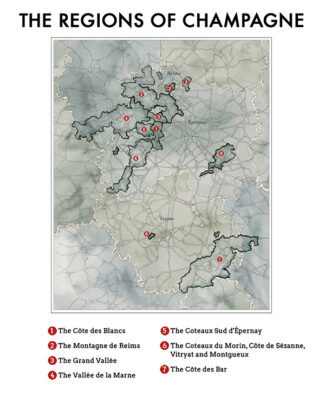
Beyond the overview lies a permutation of particulars; there are nearly as many micro-terroirs in Champagne as there are vineyard plots. Climate, subsoil and elevation are immutable; the talent, philosophies and techniques of the growers and producers are not. Ideally, every plot is worked according to its individual profile to establish a stamp of origin, creating unique wines that complement or contrast when final cuvées are created.
Champagne is predominantly made up of relatively flat countryside where cereal grain is the agricultural mainstay. Gently undulating hills are higher and more pronounced in the north, near the Ardennes, and in the south, an area known as the Plateau de Langres, and the most renowned vineyards lie on the chalky hills to the southwest of Reims and around the town of Epernay. Moderately steep terrain creates ideal vineyard sites by combining the superb drainage characteristic of chalky soils with excellent sun exposure, especially on south and east facing slopes.
Exploring Pinot Country: The Montagne de Reims
Whether based on tradition or technical savvy, the choice of the grape variety and rootstock best suited to a specific plot is an indispensable factor in determining the ultimate success of any lieu-dit, or named vineyard. Whereas most Champagne is a blend of Pinot Noir and Chardonnay, both grapes make unique demands on terroir, and where one may thrive, the other may not. Sandwiched between the Marne and the Vesle Rivers, forming a broad headland of forests and thickets, the Montagne de Reims is particularly suited to the former; Pinot Noir vines carpet the western and northern flanks to form a vast semicircle extend from Louvois to Villers-Allerand, encompassing the famous villages of Bouzy and Ambonnay.
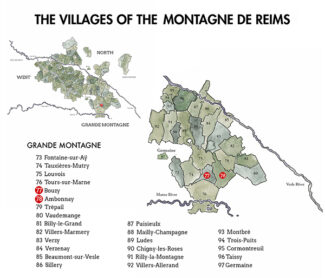
Bouzy and Ambonnay: Twin Grands Crus, Always Rivals
Like Elizabeth I and Mary Queen of Scots, the Grand Crus of Bouzy and Ambonnay co-exist in begrudging mutual respect and rivalry, and unless one figures out how to sign the other’s death warrant, this will continue for the foreseeable future. At its closest point, the distance between the two communes is less than a long drive with a golf club, and each have shored up a reputation for superlative wines from the south side of the Montagne de Reims hill.
With a population just under one thousand, Bouzy is the best known Champagne village to produce still wine (Bouzy Rouge) along with its legendary Pinot Noir-focused sparkling wine. More than nine hundred acres in Bouzy are under vine, with 87% of them Pinot Noir, 12% Chardonnay and a scant 0.2% Meunier. The most prominent Champagne houses with a Bouzy presence are Bollinger, Duval-Leroy, Moët & Chandon, Mumm, Pol Roger and Taittinger.
Nearby Ambonnay shares a nearly identical terroir with Bouzy on the south side of the Montagne de Reims hill, and is similarly appointed, although with slightly less Pinot Noir grown and a bit more Chardonnay—white grapes accounts for about 20% of the vineyards. Like Bouzy, ‘Ambonnay Rouge’ represents a small portion of wine production. Prominent Champagne houses that control Ambonnay vineyards include Duval Leroy, Moët & Chandon, Mumm, Piper Heidsieck, Pol Roger and Roederer.
Champagne André Clouet
A Custodian of Bouzy and Ambonnay
Somewhat less prominent than the powerhouse producers mentioned above is grower-producer Jean-François Clouet of Champagne André Clouet, although Champagne Clouet has been around longer. The Clouet family traces its Bouzy roots to 1492 and at one time was the official printmakers for the court of King Louis XV; the classically pretty labels that grace their Champagne bottles today pay homage to their aesthetic history. Clouet grapes are sourced exclusively from 20 acres of coveted mid-slope vineyards in the Grand Cru villages of Bouzy and Ambonnay.
Born and raised in Bouzy, Jean-François still lives in his family’s 18th century home; with inimitable wit, he refers to himself as ‘a combination of winemaker and circus ringmaster.’ In fact, the French refer to him as ‘chef de cave’—a cellar master. He is arguably the region’s most qualified historian and insists that, without acknowledging the role that the past has played on his winemaking decisions, you can’t truly appreciate his wines.
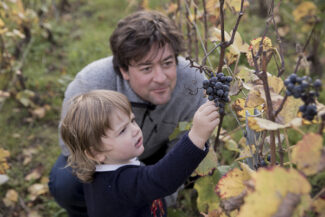 “To understand Champagne as a whole you need to understand its political history,” he says. “Attila the Hun, the Crusaders, the Templars and Marie Antoinette have all walked here; the birth of the monarchy and the Battle of the Cathalunian Fields took place nearby. In 1911, my great grandfather designed the label that graces our bottles today; I like the idea of the work of human hands in pruning, performing the same actions as my grandfather and even the Romans, who planted vines here 2000 years ago.”
“To understand Champagne as a whole you need to understand its political history,” he says. “Attila the Hun, the Crusaders, the Templars and Marie Antoinette have all walked here; the birth of the monarchy and the Battle of the Cathalunian Fields took place nearby. In 1911, my great grandfather designed the label that graces our bottles today; I like the idea of the work of human hands in pruning, performing the same actions as my grandfather and even the Romans, who planted vines here 2000 years ago.”
‘One Day in 1911 …’ A Champagne Fairytale
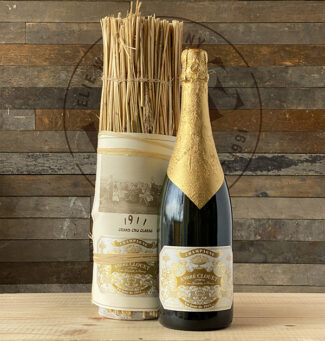
Champagne André Clouet ‘Un Jour de 1911…’ Grand Cru Bouzy, Brut ($72)
Commemorating the year Jean-François Clouet’s great grandfather designed the bottles front label, ‘Un Jour de 1911…’ is the domain’s tête de cuvée, with production limited to 1,911 bottles per disgorgement. Made from 100% Pinot Noir sourced from the Clouet’s ten best lieux-dits in the Grand Cru vineyards of Bouzy, the wine has been aged for six years on the lees—a remarkable span for a non-vintage Champagne. This release had a disgorgement date of September, 2021and is dosed at 6 grams per liter. It is delicately perfumed with sweet rose petal and jasmine and framed in austere minerality and balanced autolytic notes. Despite the relatively recent disgorgement, the mousse presents itself as extraordinarily elegant.
The ‘Dream’ Collection
A Vertical Exploration: Retrospective Spanning A Decade
Champagne André Clouet’s ‘Dream’ collection is a retrospective of Champagne’s top vintages over the past decade or so, each release labeled in a distinct color based on Cadillacs from the 1950s; Jean-François attempt to duplicate a ‘dream’ era for automotive elegance and power. A blend of the sharp, acidic Chardonnays of Mesnil-sur-Oger with the richer Chardonnays of Bouzy, the wines showcase the highest expression of Blanc de Blancs produced by the domain.
Vintage Champagnes represent less than 5 percent of all Champagne production, typically produced only in select vintages. Vintage Champagne is aged for a minimum of three years in the bottle, as opposed to 15 months for non-vintage versions. “Aging is a luxury factor,” says James Beard Award-winning sommelier Belinda Chang: “There’s a lot of painstaking work and labor and real estate required to bring those gorgeous bottles of Champagne to us. Not only are they sourcing grapes from their best vintage, but the grapes are coming from highly venerated vineyards.”
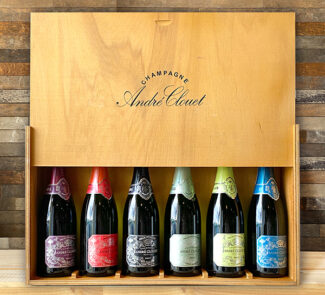
This six-bottle set is an excellent opportunity to sample the nuances of each of a half dozen notable growing seasons for Champagne André Clouet. A limited release of 36 sets were assembled by the producer specially for Elie Wine Co. ($489)
1- 2004 Dream – Champagne André Clouet – Brut
2004 was an extremely good vintage throughout Champagne; a cool spring warmed up in time to ensure a successful budburst and flowering. A sunny summer followed and conditions were so favorable that some producers had to green harvest to curb the overabundance of leaf growth. The previous year’s drought meant that water-tables within the soils were limited, subjecting the vines to slight water stress and concentrating the fruit—a good thing, in this case. Clouet’s 2004 offers a complex core of brioche, apples, citrus and chalky minerality.
2- 2005 Dream – Champagne André Clouet – Brut
2005 was an excellent vintage, just short of outstanding. A dry winter and a bright spring allowed for a successful budburst and flowering, and good weather hung around until July, when persistent rains showers brought both humidity and mildew. Conditions marginally dried out in August, but temperatures were also cooler beyond the one significant heat spike that kick-started ripening. September delivered the warm, steady conditions needed to dry out the vines and push the surviving grapes to phenolic ripeness, while cool nights helped retain essential acidity and aromatics. 2005 ‘Dream’ shows layers of mineral-infused stone fruit on a silky, mid-weight frame, with gorgeous length and a refined, subtle mousse.
3- 2006 Dream – Champagne André Clouet – Brut
Overall, 2006 was average in Champagne, with good wines made only by circumspect vignerons. Flowering was excellent, but the growing season was defined by a markedly dry summer, with June and July delivering a series of searingly hot weeks and a premature ripening of berries. A significant mid-summer thunderstorm pelted various vineyards with hail, following which, the sunny streak did not return until early autumn. A gloomy August brought humidity inspiring rot, mildew and unwanted bouts of botrytis. Fortunately, September saw a return of warm, dry days which helped push the fruit to phenolic ripeness while cool nights were conducive to preserving essential acidity. 2006 Clouet offers wonderful bouquet of apples and poached pear along with buttered brioche and palate rich in salty minerals and a touch of hazelnut praline.
4- 2008 Dream – Champagne André Clouet – Brut
In Champagne, the 2008 vintage was sublime, especially in Bouzy. To earn such distinction, cooler summer weather is almost a requirement—for grapes to reach phenolic ripeness sufficient to harvest, it helps is the process is slow and steady. The only downside of 2008 was the global recession which drove prices downward and effected every aspect of Champagne production. Although the region was hit hard by economics, the 2008 vintage is considered nearly legendary for quality. Clouet’s 2008 expresses the pedigree of the vintage: Complex and nuanced, it boasts dried pear, mint, chamomile, crushed rock, dried flowers and pastry overtones laced together over an acidic core.
5- 2009 Dream – Champagne André Clouet – Brut
2009 was a fabulous vintage in Champagne; a dry winter left the water table low, but spring rains quickly topped them off. Vicious storms popped up in July, hitting Aÿ fairly hard, but Bouzy came through virtually unscathed. August brought warmth and sunshine and enough dry heat to prevent rot and mildew; nights remain cool, and acidity from this vintage may be pronounced. Clouet’s 2009 is a beautifully balanced package, with acids reined in by whirlwind of creamy aromas and caramelized apple, green pear, brioche, lemon-citrus peel on the palate.
6- 2013 Dream – Champagne André Clouet – Brut
Chardonnay grapes were the clear champions in a very average growing season; 2013 suffered from a cold and wet lead-in winter and a spring in which budburst and flowering were delayed. Cooler than normal temperature subjected the vines to millerandage and coulure, cutting yields. Aube and Marne experienced tricky weather throughout much of the season and a July hailstorm further reduced the crop. Among the vintage Champagnes produced, Blanc de Blanc were the most notable, and Clouet’s 2013 is voluptuous and vibrant with lemon oil, lightly-toasted walnuts, crisp yellow apples, acacia honey and a racy, acidic finish.
- - -
Posted on 2022.02.01 in France, The Champagne Society, Champagne
Featured Wines
- Notebook: A’Boudt Town
- Saturday Sips Wines
- Saturday Sips Review Club
- The Champagne Society
- Wine-Aid Packages
Wine Regions
Grape Varieties
Aglianico, Albarino, Albarín Blanco, Albarín Tinto, Albillo, Aleatico, Arbanne, Aubun, Barbarossa, barbera, Beaune, Biancu Gentile, bourboulenc, Cabernet Franc, Cabernet Sauvignon, Caino, Caladoc, Calvi, Carcajolu-Neru, Carignan, Chablis, Chardonnay, Chasselas, Clairette, Corvina, Cot, Counoise, Erbamat, Ferrol, Fiano, Frappato, Friulano, Fromenteau, Fumin, Garnacha, Gewurztraminer, Godello, Graciano, Grenache, Grolleau, Groppello, Juan Garcia, Lambrusco, Loureira, Macabeo, Macabou, Malvasia, Malvasia Nera, Marsanne, Marselan, Marzemino, Melon de Bourgogne, Merlot, Mondeuse, Montanaccia, Montepulciano, Morescola, Morescono, Moscatell, Muscadelle, Muscat, Natural, Nero d'Avola, Parellada, Patrimonio, Petit Meslier, Petit Verdot, Pineau d'Aunis, Pinot Auxerrois, Pinot Blanc, Pinot Gris, Pinot Meunier, Pinot Noir, Poulsard, Prieto Picudo, Rondinella, Rousanne, Roussanne, Sangiovese, Sauvignon Blanc, Savignin, Semillon, Souson, Sparkling, Sumoll, Sylvaner, Syrah, Tannat, Tempranillo, Trebbiano, Trebbiano Valtenesi, Treixadura, Trousseau, Ugni Blanc, vaccarèse, Verdicchio, Vermentino, Viognier, Viura, Xarel-loWines & Events by Date
- April 2024
- March 2024
- February 2024
- January 2024
- December 2023
- November 2023
- October 2023
- September 2023
- August 2023
- July 2023
- June 2023
- May 2023
- April 2023
- March 2023
- February 2023
- January 2023
- December 2022
- November 2022
- October 2022
- September 2022
- August 2022
- July 2022
- June 2022
- May 2022
- April 2022
- March 2022
- February 2022
- January 2022
- December 2021
- November 2021
- October 2021
- September 2021
- August 2021
- July 2021
- June 2021
- May 2021
- April 2021
- March 2021
- February 2021
- January 2021
- December 2020
- November 2020
- October 2020
- September 2020
- August 2020
- July 2020
- June 2020
- May 2020
- April 2020
- March 2020
- February 2020
- January 2020
- December 2019
- November 2019
- October 2019
- September 2019
- August 2019
- July 2019
- June 2019
- May 2019
- April 2019
- March 2019
- February 2019
- January 2019
- December 2018
- November 2018
- October 2018
- September 2018
- August 2018
- July 2018
- June 2018
- May 2018
- April 2018
- March 2018
- February 2018
- January 2018
- December 2017
- November 2017
- October 2017
- September 2017
- August 2017
- July 2017
- June 2017
- May 2017
- April 2017
- March 2017
- February 2017
- January 2017
- December 2016
- November 2016
- October 2016
- September 2016
- August 2016
- July 2016
- June 2016
- May 2016
- April 2016
- March 2016
- February 2016
- January 2016
- December 2015
- November 2015
- October 2015
- September 2015
- August 2015
- July 2015
- June 2015
- May 2015
- April 2015
- March 2015
- February 2015
- January 2015
- December 2014
- November 2014
- October 2014
- September 2014
- August 2014
- July 2014
- June 2014
- April 2014
- March 2014
- February 2014
- January 2014
- December 2013
- November 2013
- October 2013
- September 2013
- August 2013
- July 2013
- June 2013
- May 2013
- April 2013
- March 2013
- February 2013
- January 2013
- December 2012
- November 2012
- October 2012
- February 2004
Search



